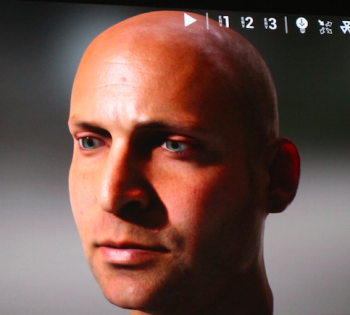
Human faces generated by Tegra K1 powered tablets will blow you away
The power of mobile processors has grown considerably in the past few years, but last night, NVIDIA whipped out a Carl Lewis triple jump by announcing the 192-core Tegra K1 processor.
The press conference went on for a couple hours, discussing everything from the nitty gritty specs, to impact on the automotive industry, and even crop circles NVIDIA employees made as a low budget marketing idea. It was all good stuff, but I was sold on the Tegra K1 with one demo: human faces generated in real-time.
That might be the most lifelike human faces I’ve ever seen generated by a computer. The picture simply doesn’t do justice. It was the realism in the facial expressions. The fluidity with which the brow furrowed and the lips puckered. Look at the small crescent of light peering through the thin cartilage of the ear. The quality of images generated with the Tegra K1 was nothing short of amazing. I was in awe.
We got a nice hands-on look at the face simulation in action:
If this type of realism could be brought to real environments in gameplay, we could be seeing game experiences that parallel Xbox One, PS4, and PC directly on our Android tablets. They took another step to showing us just that with a living room setting. It may seem crazy, but I fell in love with this couch.
Moving around the room and directly up to the couch made the environment feel absolutely real, not computer generated. Take a look at this couch, the texture of the fabric, and the way it sits and folds on the back cushions.
Reminds me a bit of the movie Inception where “the architect” perfectly re-imagines the real world in a dream world, with the subjects only being able to differentiate the difference by actually feeling the surface. This couch looks so real and so comfortable, I’m worried what Rick James would do to it or say about it.
It went much further than just the couch, obviously. It was the grain of the hardwood floor. The way the light reflected and refracted on different objects appropriately, from the dense soak of rubber to the shiny glaze of chrome trashcans. For the Tegra K1, it’s all about the details, especially the spot-on details you may overlook if you didn’t know any better.
The face and room simulations were nothing short of spectacular but toss in thousands of computer AI generated in-game activities and the story might be a little bit different. Enemies running here and there while reacting to your gameplay, different explosions going off in the foreground and background, all these simultaneous processor intensive activities distribute the processor’s attention across different tasks, making it more difficult to render these real life settings in realtime.
NVIDIA showed some in-game examples of the Tegra K1 at work, but to honest, they didn’t shine like the face simulation and the room simulation above. I’m not surprised, nor worried. The K1 is fresh off the assembly line and clearly has “alpha” stamped on its forehead. They’ve got improvements to make, but if NVIDIA can make gameplay look, feel, and perform like some of these demos… we’re all in for a big treat when “next gen” gaming (and automative) firmly plant their feet.